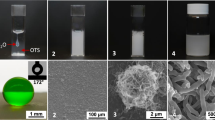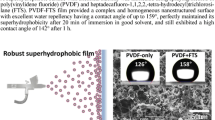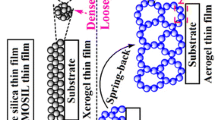Abstract
Superhydrophobic surfaces were obtained easily from a mixed solution of hydrogenated castor oil (HCO) as an organogelator and a fatty acid as a crystalline compound by a casting method: a contact angle of 160° ± 2° and a sliding angle of 5° ± 1° were achieved on a surface prepared from the mixed solution of HCO and stearic acid (SA) at 6:4 weight ratios at 30 °C. The superhydrophobicity of the surface was attributable to a hierarchical structure which consisted of self-assembled nano-fibers of HCO and nano/micrometer-scale crystals of SA on hemispherical sub-structures having a diameter of several tens of micrometers. The hierarchical structure was formed under controlled conditions involving mixing ratios of HCO and a fatty acid, preparation temperatures, and fatty acid species. These results indicated that balance between gelation of HCO and crystallization of a fatty acid in the casting process was of importance in producing superhydrophobic surfaces.










Similar content being viewed by others
References
Burton Z, Bhushan B (2006) Surface characterization and adhesion and friction properties of hydrophobic leaf surfaces. Ultramicroscopy 106:709–719. doi:10.1016/j.ultramic.2005.10.007
Ensikat HJ, Ditsche-Kuru P, Neinhuis C, Barthlott W (2011) Superhydrophobicity in perfection: the outstanding properties of the lotus leaf. Beilstein J Nanotechnol 2:152–161. doi:10.3762/bjnano.2.19
Koch K, Bhushan B, Barthlott W (2009) Multifunctional surface structures of plants: an inspiration for biomimetics. Prog Mater Sci 54:137–178. doi:10.1016/j.pmatsci.2008.07.003
Prathapan R, Venkatesan AG, Nair SV, Nair S (2014) A review on ‘self-cleaning and multifunctional materials’. J Mater Chem A 2:14773–14797. doi:10.1039/C4TA02542C
Guo Z, Liu W, Su B-L (2011) Superhydrophobic surfaces: from natural to biomimetic to functional. J Colloid Interface Sci 353:335–355. doi:10.1016/j.jcis.2010.08.047
Latthe SS, Gurav AB, Maruti CS, Vhatkar RS (2012) Recent progress in preparation of superhydrophobic surfaces: a review. JSEMAT 2:76–94. doi:10.4236/jsemat.2012.22014
Qu M, He J, Zhang J (2010) Superhydrophobicity, learn from the lotus leaf. In: Mukherjee A (ed) Biomimetics learning from nature. InTech, India, pp 325–342. doi:10.5772/55321
Zhang Y-L, Xia H, Kim E, Sun H-B (2012) Recent developments in superhydrophobic surfaces with unique structural and functional properties. Soft Matter 8:11217–11231. doi:10.1039/c2sm26517f
Xue C-H, Ma Z-JJ (2013) Long-lived superhydrophobic surfaces. Mater Chem A 1:4146–4161. doi:10.1039/C2TA01073A
Meng Z, Yang W, Chen P, Wang W, Jia X, Xi K (2013) Preparation of disk-like particles with micro/nano hierarchical structures. J Colloid Interface Sci 408:1–5. doi:10.1016/j.jcis.2013.07.025
Xue C-H, Jia S-T, Zhang J, Ma J-Z (2010) Large-area fabrication of superhydrophobic surfaces for practical applications: an overview. Sci Technol Adv Mater 11:033002. doi:10.1088/1468-6996/11/3/033002 (15pp)
Tang X, Wang T, Yu F, Zhang X, Zhu Q, Pang L, Zhang G, Pei M (2013) Simple, robust and large-scale fabrication of superhydrophobic surfaces based on silica/polymer composites. RSC Adv 3:25670–25673. doi:10.1039/C3RA44502J
Zhang BT, Liu BL, Deng XB, Cao SS, Hou XH, Chen HL (2008) Fabricating superhydrophobic surfaces by molecular accumulation of polysiloxane on the wool textile finishing. Colloid Polym Sci 286:453–457. doi:10.1007/s00396-007-1801-y
Suzuki M, Hanabusa K (2010) Polymer organogelators that make supramolecular organogels through physical cross-linking and self-assembly. Chem Soc Rev 39:455–463. doi:10.1039/B910604A
George M, Weiss RG (2006) Molecular organogels. Soft matter comprised of Low-molecular-mass organic gelators and organic liquids. Acc Chem Res 39:489–497. doi:10.1021/ar0500923
Yu G, Yan X, Han C, Huang F (2013) Characterization of supramolecular gels. Chem Soc Rev 42:6697–6722. doi:10.1039/C3CS60080G
Yamanaka M, Sada K, Miyata M, Hanabusa K, Nakano K (2006) Construction of superhydrophobic surfaces by fibrous aggregation of perfluoroalkyl chain-containing organogelators. Chem Commun 21:2248–2250. doi:10.1039/B601485B
Raghavanpillai A, Reinartz S, Hutchenson KW (2009) Hydrophobic and oleophobic surface modification using fluorinated bis-urea and bis-amide gelators. J Fluorine Chem 130:410–417. doi:10.1016/j.jfluchem.2009.01.006
Raghavanpillai A, Franco VA (2012) Self-assembled fluorinated organogelators for surface modification. Appl Sci 2:175–191. doi:10.3390/app2010175
Zhou Y, Yi T, Li T, Zhou Z, Li F, Huang W, Huang C (2006) Morphology and wettability tunable two-dimensional superstructure assembled by hydrogen bonds and hydrophobic interactions. Chem Mater 18:2974–2981. doi:10.1021/cm052805h
Nakano K, Akita S, Yamanaka M (2014) Fabrication of superhydrophobic surfaces from mixtures of aluminum distearate and fatty acids via intermediate organogel formation. Colloid Polym Sci 292:1475–1478. doi:10.1007/s00396-014-3219-7
Author information
Authors and Affiliations
Corresponding author
Electronic supplementary material
Below is the link to the electronic supplementary material.
ESM 1
(DOCX 3302 kb)
Rights and permissions
About this article
Cite this article
Nakano, K., Ito, T., Onouchi, Y. et al. Importance of gelation and crystallization for producing superhydrophobic surfaces from mixtures of hydrogenated castor oil and fatty acids. Colloid Polym Sci 294, 69–75 (2016). https://doi.org/10.1007/s00396-015-3748-8
Received:
Accepted:
Published:
Issue Date:
DOI: https://doi.org/10.1007/s00396-015-3748-8




